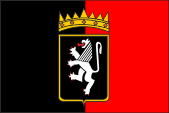Aostatal |
|
|
|
| Übersicht – Contents: | |
Diese Seite ist Teil des Projektes
Aostatal |
|
|
|
| Übersicht – Contents: | |
Flagge – Flag: |
|
 |
Flagge des Aostatals – flag of the Aosta Valley, Seitenverhältnis – ratio = 2:3, Quelle/Source: nach/by: Wikipedia (D) |
 |
Variante mit Wappen – variant with coat of arms, Seitenverhältnis – ratio = 2:3, Quelle/Source: nach/by: flagsonline.it |
Bedeutung/Ursprung der Flagge – Meaning/Origin of the Flag: |
|
| Die Flagge des Aostatals zeigt zwei senkrechte Streifen in Rot und Schwarz und in der Mitte das Wappen der Region. Dieses zeigt einen golden umrandeten Schild mit einem silbernen Löwen auf Schwarz. Über dem Wappen erscheint eine goldene Krone. Über den Ursprung des Wappens ist nichts bekannt. Es gibt auch Versionen der Flagge ohne Wappen. | The flag
of Aosta Valley shows two vertical stripes in red and black and in the
middle the coat of arms of the region. This shows a golden bordered shield with a silvery lion on black. The origin of the arms is not known. There are also versions of the flag without a coat of arms. |
| Quelle/Source: nach/by: Wikipedia (D) | |
Landkarte der
Regionen Italiens – Map of the Regions of Italy: |
|
| Landkarte/Map: Volker Preuß |
Zahlen und Fakten – Numbers and Facts: |
|
|
|
|
|
|
|
|
|
|
|
|
|
Geschichte: |
|
2000 v.Chr.
· Einwanderung des Salassi-Volkes 1500 v.Chr. · Einwanderung von Kelten 4.Jhd. v.Chr. bis 25 v.Chr. · römische Eroberung, das Aostatal kommt zur zur Provinz Italia 401 · Abzug der letzten römischen Truppen 443 · das Aostatal kommt zum Reich der Burgunder 534 · Eroberung durch die Franken, Eingliederung des Aostatals in das Frankenreich der Karolinger 870 · bei der Teilung der Karolingischen Reiche kommt das Aostatal zum Königreich Italien 880 · bei einer erneuten Teilung der Karolingischen Reiche kommt das Aostatal zum Königreich Hochburgund 933 · Hochburgund und Niederburgund werden zum Königreich Burgund (Arelat) vereinigt 10. Jhd. · Enfälle von Ungarn und Sarazenen 1032/34 · Burgund (einschließlich Aostatal) kommt an das Deutsche Königreich 1095 · das Aostatal wird Grafschaft des Königreichs Burgund 1191 · das Aostatal kommt an die Grafschaft Savoyen, erhält jedoch einen autonomen Sonderstatus 1720 · Vereinigung Sardiniens mit dem Land Savoyen-Piemont, Errichtung des Königreichs Sardinien-Piemont durch das Haus Savoyen 1770 · das Haus Savoyen beendet den autonomen Sonderstatus und bindet das Tal eng an das Königreich Sardinien-Piemont 1797 · nach der Eroberung durch französische Truppen verbleibt das Aostatal bei Piemont (napolèonischer Satellitenstaat) 1802 · Annexion ganz Piemonts durch das napolèonische Frankreich 1814 · das Königreich Sardinien-Piemont wird wiederhergestellt 1859 · Unabhängigkeitskrieg gegen Österreich im heutigen Norditalien, Frankreich greift ein, Österreich verliert und räumt Norditalien, Frankreich annektiert das Land Savoyen ohne das Aostatal 1861 · König Vittorio Emanuele von Sardinien-Piemont proklamiert das Königreich Italien 1881 · die Regionen Aostatal und Piemont werden vereinigt 1945 · des Aostatal erhält einen autonomen Status innerhalb der Region Piemont 1947 · das Aostatal spaltet sich von Piemont ab 1948 · Anerkennung der Autonomie des Aostatals, Einrichtung der italienischen Region Aostatal 1971 · die Stadt Aosta wird als Hauptstadt endgültig anerkannt |
History: |
|
2000 B.C.
· immigration of the Salassi people 1500 B.C. · immigration of Celts 4th cent. B.C. to 25 B.C. · Roman conquest, the Aosta Valley comes to the Province of Italia 401 · withdrawal of the last Roman troops 443 · the Aosta Valley comes to the Empire of the Burgundians 534 · conquest by the Franks, incorporation of the Aosta Valley into the Frankish Empire of the Carolingians 870 · at the partition of the Carolingian empire comes the Aosta Valley to the Kingdom of Italy 880 · at a once more partition of the Carolingian empire comes the Aosta Valley to the Kingdom of Upper Burgund 933 · Upper Burgund and Lower Burgund get united to the Kingdom of Burgund (Arelate) 10th cent. · invasions of Hungarians and Saracenes 1032/34 · Burgund (inclusive Aosta Valley) comes to the German Kingdom 1095 · the Aosta Valley becomes a county of the Kingdom of Burgund 1191 · the Aosta Valley comes to the County of Savoy, but gets an autonomous special status 1720 · unification of Sardinia with the country of Savoy-Piedmont, establishment of the Kingdom of Sardinia-Piedmont by the house of Savoy 1770 · the house of Savoy terminates the autonomous special status and ties the valley close to the Kingdom of Sardinia-Piedmont 1797 · after the conquest by French troops remains the Aosta Valley at Piedmont (napolèonic satellite state) 1802 · annexation of whole Piedmont by the Napolèonic France 1814 · the Kingdom of Sardinia-Piedmont gets restored 1859 · war of independence against Austria, France intervenes, Austria loses and leaves from Italy, France annexes the Country of Savoy without the Aosta Valley 1861 · king Vittorio Emanuele of Sardinia-Piedmont proclaims the Kingdom of Italy 1881 · the regions of Aosta Valley and Piedmont get united 1945 · the Aosta Valley gets an autonomous status within the Region of Piedmont 1947 · the Aosta Valley separates from Piedmont 1948 · recognition of the Aosta Valley's autonomy, establishment of the Italian Region of Aosta Valley 1971 · Aosta Town gets irrevocably recognized as the capital |
| Quelle/Source: Atlas zur Geschichte, Wikipedia (D), World Statesmen |
Ursprung des Landesnamens – Origin of the Country's Name: |
|
| Der Name "Aosta" geht auf die Römische Ortsbezeichnung "Augusta Praetoria" zurück. | The name "Aosta" goes back to the Roman place named "Augusta Praetoria". |
| Quelle/Source: Handbuch der geographischen Namen | |